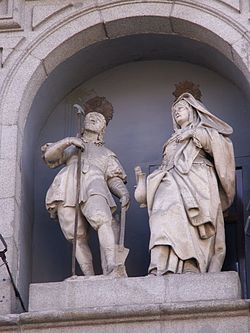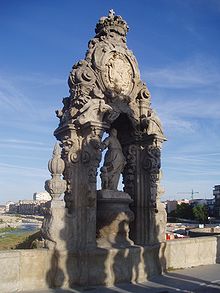- Maria Torribia
-
Saint Maria Torribia 
Statues of Isidore and Maria Torribia (María de la Cabeza). Main facade of the Colegiata de San Isidro, Madrid.Born Uceda Died ~1175 AD Honored in Roman Catholic Church Feast September 9; May 15 (with Isidore) Maria Torribia (d. ~1175) was a Spanish peasant woman who is believed to have married Saint Isidore. She herself was eventually beatified by the Roman Catholic Church, and is known in Spain as Santa María de la Cabeza (in English, "Saint Mary of the Head").
Torribia is believed to have been born in Uceda, in the Spanish province of Guadalajara. She subsequently lived in Torrelaguna, in Madrid Province, close to Guadalajara. There, she met and married Isidore, a simple farmer from Madrid (who, according to some sources, had fled there as a result of the Almoravid invasion),[1] with whom she would have her only son. According to legend, the child one day fell down a deep well, leaving the parents with no recourse but prayer. Miraculously, the water level suddenly rose to the level of the ground, and the floating baby was easily rescued unharmed. As a result of this, she and her husband committed themselves to sexual abstinence as a form of devotion, and, from that time on, lived in different homes. However, their son would later die in childhood.
Torribia substantially outlived her husband, who died in 1130. After his death, she lived as a hermit, performed miracles, and had visions. For instance, legend suggests that every night she dreamed of the Virgin Mary, who would cross the Jarama River while extending her pure cloak over the waters.
Veneration
It appears that her remains were officially transferred to Torrelaguna in 1615, more than 400 years after her estimated death between 1175 and 1180. Her beatification by Pope Innocent XII on August 11, 1697, made her and Saint Isidore the only beatified husband and wife. The somewhat unusual title "Santa María de la Cabeza" is derived from the most prominent relic associated with Torribia, a head said to be her own. This relic is often used in processions, and is traditionally an intercessory tool for the relief of drought[citation needed]. Revered by farm workers throughout the Catholic world, she shares a feast day with her husband (May 15), while also having her own on September 9.
References
External links
Categories:- People from Guadalajara (province)
- Women of medieval Spain
- 12th-century Spanish people
- Spanish saints
- Spanish Roman Catholic saints
Wikimedia Foundation. 2010.

